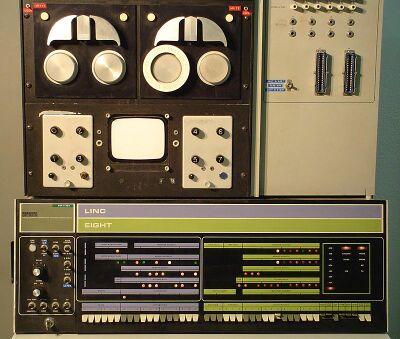Difference between revisions of "LINC-8"
(Note PDP-12 as successor; →External links: create; move tape image link here; link to online Small Computer Handbook)) |
(12-bit cat.) |
||
| (2 intermediate revisions by one other user not shown) | |||
| Line 1: | Line 1: | ||
| − | The '''LINC-8''' was a computer produced by [[Digital Equipment Corporation|DEC]] for use in laboratory settings; it included both a [[PDP-8]] and a [[LINC]] computer, which shared access to the PDP-8's [[main memory]] (the LINC acted as a [[Direct Memory Access|DMA]] peripheral to the PDP-8, using the PDP-8 [[data break]] mechanism). A combined [[front panel]] allowed control of both | + | The '''LINC-8''' was a computer produced by [[Digital Equipment Corporation|DEC]] for use in laboratory settings; it included both a [[PDP-8]] (the original model's [[Central Processing Unit|CPU]]) and a [[LINC]] computer, which shared access to the PDP-8's [[main memory]] (the LINC acted as a [[Direct Memory Access|DMA]] peripheral to the PDP-8, using the PDP-8 [[data break]] mechanism). A combined [[front panel]] allowed control of both CPUs. |
Like the LINC, it included a video [[display]] (512x512 pixels [[resolution]], but not a [[bit-mapped display]]), analog inputs, and [[LINC tape]] drives (all attached to the LINC); it could also include any of the standard PDP-8 [[peripheral]]s (attached to the PDP-8). | Like the LINC, it included a video [[display]] (512x512 pixels [[resolution]], but not a [[bit-mapped display]]), analog inputs, and [[LINC tape]] drives (all attached to the LINC); it could also include any of the standard PDP-8 [[peripheral]]s (attached to the PDP-8). | ||
Special [[interrupt]]-driven code ('PROGOFOP' - 'program of operation') in the PDP-8 allowed code running in the LINC access to PDP-8 resources; the PDP-8 likewise had access to the resources of the LINC (e.g. the display). When the PDP-8 was in control, the LINC was halted until the PDP-8 wanted something done, whereupon an interrupt started the LINC running, to perform the desired action. | Special [[interrupt]]-driven code ('PROGOFOP' - 'program of operation') in the PDP-8 allowed code running in the LINC access to PDP-8 resources; the PDP-8 likewise had access to the resources of the LINC (e.g. the display). When the PDP-8 was in control, the LINC was halted until the PDP-8 wanted something done, whereupon an interrupt started the LINC running, to perform the desired action. | ||
| + | |||
| + | Like its PDP-8, the LINC of the LINC-8 was also constructed of discrete [[transistor]] [[FLIP CHIP]]s, mostly R- and S-series, in [[DEC card form factor|standard-length single-height]] (width) format, with a few dual-height. | ||
It was later replaced as a product for DEC by the [[PDP-12]], which had the same functionality in a more integrated form. | It was later replaced as a product for DEC by the [[PDP-12]], which had the same functionality in a more integrated form. | ||
| Line 26: | Line 28: | ||
[[Category: Personal Computers]] | [[Category: Personal Computers]] | ||
[[Category: PDP-8s]] | [[Category: PDP-8s]] | ||
| + | [[Category: 12-bit Computers]] | ||
Latest revision as of 13:46, 11 July 2023
The LINC-8 was a computer produced by DEC for use in laboratory settings; it included both a PDP-8 (the original model's CPU) and a LINC computer, which shared access to the PDP-8's main memory (the LINC acted as a DMA peripheral to the PDP-8, using the PDP-8 data break mechanism). A combined front panel allowed control of both CPUs.
Like the LINC, it included a video display (512x512 pixels resolution, but not a bit-mapped display), analog inputs, and LINC tape drives (all attached to the LINC); it could also include any of the standard PDP-8 peripherals (attached to the PDP-8).
Special interrupt-driven code ('PROGOFOP' - 'program of operation') in the PDP-8 allowed code running in the LINC access to PDP-8 resources; the PDP-8 likewise had access to the resources of the LINC (e.g. the display). When the PDP-8 was in control, the LINC was halted until the PDP-8 wanted something done, whereupon an interrupt started the LINC running, to perform the desired action.
Like its PDP-8, the LINC of the LINC-8 was also constructed of discrete transistor FLIP CHIPs, mostly R- and S-series, in standard-length single-height (width) format, with a few dual-height.
It was later replaced as a product for DEC by the PDP-12, which had the same functionality in a more integrated form.
Images
External links
- linc8 - LINC-8 at Bitsavers
- Small Computer Handbook, 1967 edition - has a section with detailed information about the LINC-8
- Images of LAP6 LINCtapes used on a LINC 8 - copies of tape contents
